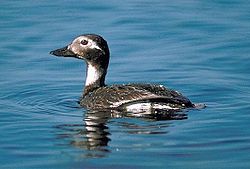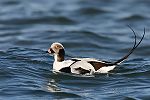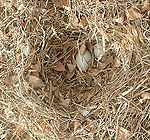Long-tailed duck
| Long-tailed duck |
|---|

|
| Scientific Classification |
|
| Binomial Name |
|
Clangula hyemalis (Linnaeus, 1758) [3] |
| mating |
The long tailed duck is a species of duck known by the scientific name Clangula hyemalis. Carolus Linnaeus observed them and assigned its name in 1758. It usually lives in the sea, generally far offshore in waters 10-35 m deep, as well as in saline, brackish or fresh estuarine waters, brackish lagoons, inland on large, and deep freshwater lakes.[4]
Body Design
The male’s body length and wing’s length is about 57cm, or 22cm, and the female’s body length is 31cm. Its color is white under the head and neck, and is dark brown under the eyes. Also, they have a black brown chest, back and wings, black beak(it is pink on the end of its beak). As its name is ‘Long Tailed Duck’, the tail feather is long. the female’s back is brown, abdomen is white, and its chest has a brown stripe. Its head is white, but the top of the head is dark brown. It is brown under the right eye.[5]
Life Cycle
The Long-tailed Duck can dive as deep as 200 feet to forage, so it is one of deepest diving ducks. They spend most of other time on the surface of water. But when they are foraging, they are submerged three to four times as much as spending on the surface. They molt twice per year.[6].They are eaten by predators such as jaguars, foxes, ravens, eagles, and humans. But they eat Mollusks, shrimp, crabs, aquatic vegetation, seeds, insects, and some fish. [7]. Male and female reproduce before or during migration. Between 6-11 eggs are laid in a depression in the ground where is close to water and hidden by vegetation. The eggs hatch in 20-25 days. The babies are precocial and feed themselves shortly. And then they flee.[8]
Ecology
The long-tailed duck lives on pond, streams, and wetlands in the tundra. In winter, it inhabits ocean shores and inland lakes. It is sometimes found away from the shore on the open ocean.[9]. The nest is made in a nature hollow on dry ground, between plants, and close to water.[10] The long-tailed duck lays their eggs on the tundra, usually near freshwater ponds and lakes. Some pairs may lay on the nest, because the nest is safe from predators. The males occupy the same territory every year. The area includes a freshwater pool where intense courtship behavior occurs.[11]
Behavior
Migration is its behavior. It breeds from late May in single pairs or loose groups. Then after incubation, the male leaves the female. The incubation is to gather in small flocks for a flightless molting period. Some ducks molt while they are flying in the sky, and others molt on water near the breeding grounds. The females molt on the water. After the breeding molt, they move between September and October for the southward autumn migration. The long-tailed duck is gregarious and gathers into huge aggregations that is to inhabit and feed in inshore and offshore waters in winter. It can dive to depths of 3-10m for foraging.[12]
Video
References
- Ondřej Zicha Long-tailed Duck Clangula hyemalis (Linnaeus, 1758). BioLib. Web. Last revised November 9, 2003
- Clangula hyemalis. Wikispecies. Web. Last revised January 21, 2011. Author unknown
- 바다꿩[oldsquaw,Clangula hyemalis. doopedia. Web. unknown date-of-publication. unknown author
- Long-tailed Duck - Clangula hyemalis. "Wildlife Journal, Junior". Web. Last revised 2011. Author unknown
- LONG-TAILED DUCK (CLANGULA HYEMALIS). "Alaska SeaLife Center". Web. unknown date-of-publication. unknown author
- Robertson, G. J., and J-P. L. Savard. Long-tailed Duck. "ALL ABOUT BIRDS". Web. Last revised 2002.
- Hallvard Strøm LONG-TAILED DUCK. "NORWEGIAN POLAR INSTITUTE". Web. unknown date-of-publication.
- Pihl, S. Clangula hyemalis. "IUCN Red List". Web. unknown date-of-publication.



